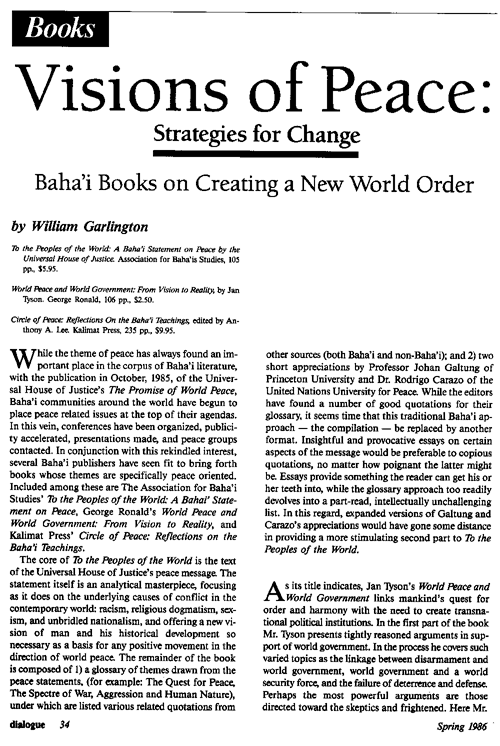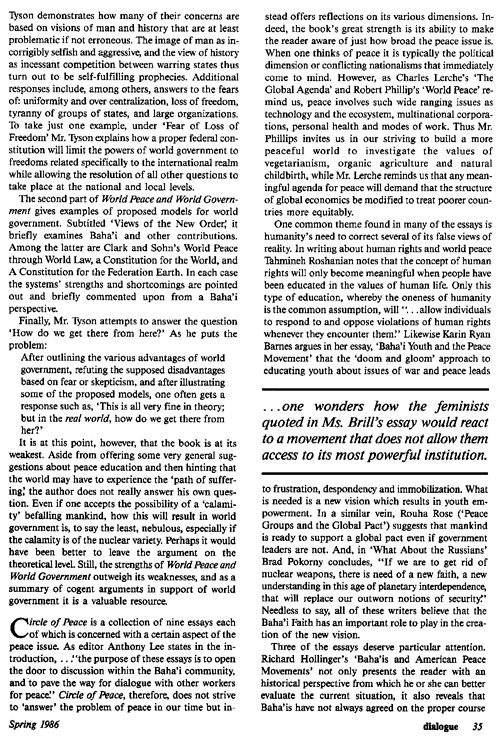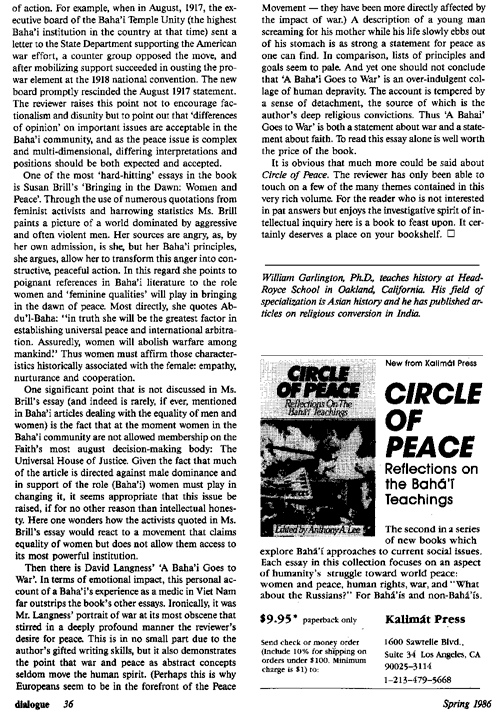
|
|
Abstract: Reviews of To the Peoples of the World: A Bahá'í Statement on Peace, by the Universal House of Justice, World Peace and World Government, by Jan Tyson, and Circle of Peace. ed. Anthony Lee. Notes: See also list of dialogue articles or image scans. |
Visions of Peace, Strategies for Change:
Bahá'í Books on Creating a New World Order
by William Garlington
published in dialogue, 1:2, pages 34-36Los Angeles: 1986
- To the Peoples of the World: A Bahá'í Statement on Peace, by the Universal House of Justice. Association for Bahá'í Studies. 105 pp. $5.95
World Peace and World Government: From Vision to Reality, by Jan Tyson. George Ronald. 106 pp. $2.50.
Circle of Peace: Reflections On the Bahá'í Teachings, edited by Anthony A. Lee. Kalimat Press. 235 pp. $9.95.
The core of To the Peoples of the World is the text of the Universal House of Justice’s peace message. The statement itself is an analytical masterpiece, focusing as it does on the underlying cause of conflict in the contemporary world: racism, religious dogmatism, sexism, and unbridled nationalism, and offering a new vision of man and his historical development so necessary as a basis for any positive movement in the direction of world peace. The remainder of the book is composed of 1) a glossary of themes drawn from the peace statements, (for example: The Quest for Peace, The Spectre of War, Aggression and Human Nature), under which are listed various related quotations from other sources (both Bahá'í and non-Bahá'í); and 2) two short appreciations by Professor Johan Galtung of Princeton University and Dr. Rodrigo Carazo of the United Nations University for Peace. While the editors have found a number of good quotations for their glossary, it seems time that this traditional Bahá'í approach—the compilation—be replaced by another format. Insightful and provocative essays on certain aspects of the message would be preferable to copious quotations, no matter how poignant the latter might be. Essays provide something the reader can get his or her teeth into, while the glossary approach too readily devolves into a part-read, intellectually unchallenging list. In this regard, expanded versions of Galtung and Carazo’s appreciations would have gone some distance in providing a more stimulating second part to To the Peoples of the World.
As its title indicates, Jan Tyson’s World Peace and World Government links mankind’s quest for order and harmony with the need to create transnational political institutions. In the first part of the book Mr. Tyson presents tightly reasoned arguments in support of world government. In the process he covers such varied topics as the linkage between disarmament and world government, world government and a world security force, and the failure of deterrence and defense. Perhaps the most powerful arguments are those directed toward the skeptics and frightened. Here Mr. Tyson demonstrates how many of their concerns are based on visions of man and history that are at least problematic if not erroneous. The image of man as incorrigibly selfish and aggressive, and the view of history as incessant competition between warring states thus turn out to be self-fulfilling prophecies. Additional responses include, among others, answers to the fears of: uniformity and over-centralization, loss of freedom, tyranny of groups of states, and large organizations. To take just one example, under “Fear of Loss of Freedom’ Mr. Tyson explains how a proper federal constitution will limit the powers of world government to freedoms related specifically to the international realm while allowing the resolution of all other questions to take place at the national and local levels.
The second part of World Peace and World Government gives examples of proposed models for world government. Subtitled ‘Views of the New Order,’ it briefly examines Bahá'í and other contributions. Among the latter are Clark and Sohn’s World Peace through World Law, a Constitution for the World, and A Constitution for the Federation Earth. In each case the systems’ strengths and shortcomings are pointed out and briefly commented upon from a Bahá'í perspective.
Finally Mr. Tyson attempts to answer the question ‘How do we get there from here?’ As he puts the problem:
After outlining the various advantages of world government, refuting the supposed disadvantages based on fear or skepticism, and after illustrating some of the proposed models, one often gets a response such as, ‘This is all very fine in theory; but in the real world, how do we get there from here?”It is at this point, however, that the book is at its weakest. Aside from offering some very general suggestions about peace education and then hinting that the world may have to experience the ‘path of suffering,’ the author does not really answer his own question. Even if one accepts the possibility of a ‘calamity’ befalling mankind, how this will result in world government is, to say the least, nebulous, especially if the calamity is of the nuclear variety. Perhaps it would have been better to leave the argument on the theoretical level. Still, the strengths of World Peace and World Government outweigh its weaknesses, and as a summary of cogent arguments in support of world government it is a valuable resource.
Circle of Peace is a collection of nine essays each of which is concerned with a certain aspect of the peace issue. As editor Anthony Lee states in the introduction, “…the purpose of these essays is to open the door to discussion within the Bahá'í community, and to pave the way for dialogue with other workers for peace.” Circle of Peace, therefore, does not strive to ‘answer’ the problems of peace in our time but instead offers reflections on its various dimensions. Indeed, the book’s great strength is its ability to make the reader aware of just how broad the peace issue is. When one thinks of peace it is typically the political dimension or conflicting nationalism that immediately come to mind. However, as Charles Lerche’s ‘The Global Agenda’ and Robert Phillip’s ‘World Peace’ remind us, peace involves such wide ranging issues as technology and the ecosystem, multinational corporations, personal health and modes of work. Thus Mr. Phillips invites us in our striving to build a more peaceful world to investigate the values of vegetarianism, organic agriculture and natural childbirth, while Mr. Lerche reminds us that any meaningful agenda for peace will demand that the structure of global economics be modified to treat poorer countries more equitably.
One common theme found in many of the essays is humanity’s need to correct several of its false views of reality. In writing about human rights and world peace Tahmineh Roshanian notes that the concept of human rights will only become meaningful when people have been educated in the values of human life. Only this type of education, whereby the oneness of humanity is the common assumption, will “…allow individuals to respond to and oppose violations of human rights whenever they encounter them.” Likewise Karin Ryan Barnes argues in her essay, ‘Bahá'í Youth and the Peace Movement’ that the ‘doom and gloom’ approach to educating youth about issues of war and peace leads to frustration, despondency and immobilization. What is needed is a new vision which results in youth empowerment. In a similar vein, Rouha Rose (‘Peace Groups and the Global Pact’) suggests that mankind is ready to support a global pact even if government leaders are not. And, in ‘What About the Russians’ Brad Pokorny concludes, “If we are to get rid of nuclear weapons, there is need of a new faith, a new understanding in this age of planetary interdependence, that will replace our outworn notions of security.” Needless to say, all of these writers believe that the Bahá'í Faith has an important role to play in the creation of the new vision.
Three of the essays deserve particular attention. Richard Hollinger’s ‘Bahá'ís and American Peace Movements’ not only presents the reader with an historical perspective from which he or she can better evaluate the current situation, it also reveals that Bahá'ís have not always agreed on the proper course of action. For example, when in August, 1917, the executive board of the Bahá'í Temple Unity (the highest Bahá'í institution in the country at that time) sent a letter to the State Department supporting the American war effort, a counter group opposed the move, and after mobilizing support succeeded in ousting the pro-war element at the 1918 national convention. The new board promptly rescinded the August 1917 statement. The reviewer raises this point not to encourage factionalism and disunity but to point out that ‘differences of opinion’ on important issues are acceptable in the Bahá'í community, and as the peace issue is complex and multi-dimensional, differing interpretations and positions should be both expected and accepted.
One of the most ‘hard-hitting’ essays in the book is Susan Brill’s ‘Bringing in the Dawn: Women and Peace.’ Through the use of numerous quotations from feminist activists and harrowing statistics Ms. Brill paints a picture of a world dominated by aggressive and often violent men. Her sources are angry, as, by her own admission, is she, but her Bahá'í principles, she argues, allow her to transform this anger into constructive, peaceful action. In this regard she points to poignant references in Bahá'í literature to the role women and ‘feminine qualities’ will play in bringing in the dawn of peace. Most directly, she quotes ‘Abdu'l-Bahá: “in truth she will be the greatest factor in establishing universal peace and international arbitration. Assuredly, women will abolish warfare among mankind.” Thus women must affirm those characteristics historically associated with the female: empathy, nurturance and cooperation.
One significant point that is not discussed in Ms. Brill’s essay (and indeed is rarely, if ever, mentioned in Bahá'í articles dealing with the equality of men and women) is the fact that at the moment women in the Bahá'í community are not allowed membership on the Faith’s most august decision-making body: The Universal House of Justice. Given the fact that much of the article is directed against male dominance and in support of the role (Bahá'í) women must play in changing it, it seems appropriate that this issue be raised, if for no other reason than intellectual honesty. Here one wonders how the activists quoted in Ms. Brill’s essay would react to a movement that claims equality of women but does not allow them access to its most powerful institution.
Then there is David Langness’ ‘A Bahá'í Goes to War.’ In terms of emotional impact, this personal account of a Bahá'í’s experience as a medic in Viet Nam far outstrips the book’s other essays. Ironically, it was Mr. Langness’ portrait of war at its most obscene that stirred in a deeply profound manner the reviewer’s desire for peace. This is in no small part due to the author’s gifted writing skills, but it also demonstrates the point that war and peace as abstract concepts seldom move the human spirit. (Perhaps this is why Europeans seem to be in the forefront of the Peace Movement—they have been more directly affected by the impact of war.) A description of a young man screaming for his mother while his life slowly ebbs out of his stomach is as strong a statement for peace as one can find. In comparison, lists of principles and goals seem to pale. And yet one should not conclude that ‘A Bahá'í Goes to War’ is an over-indulgent collage of human depravity. The account is tempered by a sense of detachment, the source of which is the author’s deep religious convictions. Thus ‘A Bahá'í Goes to War’ is both a statement about war and a statement about faith. To read this essay alone is well worth the price of the book.
It is obvious that much more could be said about Circle of Peace. The reviewer has only been able to touch on a few of the many themes contained in this very rich volume. For the reader who is not interested in pat answers but enjoys the investigative spirit of intellectual inquiry here is a book to feast upon. It certainly deserves a place on your bookshelf.
William Garlington, Ph.D., teaches history at Head-Royce School in Oakland, California. His field of specialization is Asian history and he has published articles on religious conversion in India.
 click for larger image |
 click for larger image |
 click for larger image |
|
|